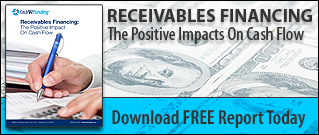 Business owners often ask me to define factoring for them. I quickly explain it to them, but after doing so, I usually ask them why they need the cash. There is a lot to be gleaned from the responses I hear back. These responses determine if the company in question has a short-term cash flow need, or if a long-term gap in working capital is likely.
Business owners often ask me to define factoring for them. I quickly explain it to them, but after doing so, I usually ask them why they need the cash. There is a lot to be gleaned from the responses I hear back. These responses determine if the company in question has a short-term cash flow need, or if a long-term gap in working capital is likely.
Answer to YOUR question: “What is factoring?”
The factoring of an invoice, at its most basic level, is getting an advance of cash in the near term for the invoice you’d otherwise have to wait for 30 to 90 days to be paid by your customer. A finance company enters into a transaction with you and purchases the invoice. The advance of cash is typically on the same day or the next day after the purchase, and is often approximately 80% of the total invoice amount. Since the business no longer owns the invoice, the business’ customer is notified to pay the finance company directly. When that payment ultimately occurs, the finance company takes a fee and remits any remaining balance owed to the business (total invoice amount paid, less the initial cash advance, less the factoring fee).
Answer to MY question: “Why do you need the cash?”
The quick answer always seems to be that cash flow is tight. But after a little prodding, the underlying need for increased cash flow often includes:
-
Need to make payroll
-
Need to buy inventory
-
Need to invest more in marketing
-
Need to make quarterly tax payment
Before people consider factoring as a method of business funding for any of the above needs, they should consider if they have a short-term or long-term need for smoother cash flow. Here is one example of each.
-
Short-term cash flow need – retail. Many small businesses that sell soft goods into the retail market deal with seasonality. For example, a friend of mine owns a growing bathing suit company and she invested a lot of her personal cash into the inventory buildup to support the holiday season sales. There is a pretty lengthy gap from the time when large retailers order from her to when she ships the goods, to when she ultimately gets paid. Because she has had success in the past, she has needed to pay her designers soon after she has shipped those bathing suits to begin work on the next line or set of designs. She has even had to make advance payments to the manufacturing facilities to start production on the next season while she is still waiting on payment from those original invoices. In her case, invoice financing smoothed out the cash flow and allowed her to grow successfully.
-
Long-term cash flow need - temporary staffing agency. When a large company hires a temporary staffing agency, they expect an immediate placement of resources, but may not pay the invoice on that resource for 30-45 days from the start date. The worker provides the work, the temporary staffing agency bills their customer after two weeks of service, but collection of the money from the customer may take 30 days or longer. So, in most cases, the temporary staffing agency has to pay the employee providing the service for two to three payroll periods before they get paid. This is an example of where invoice financing should be utilized year-round as an integral strategy for long-term success.
Which of these examples most closely fits your company? Factoring works well for these cash flow scenarios and more, and Fast A/R Funding specializes in factoring for small businesses. Download our informative “Factoring 101” guide, or call 888.833.2286 to speak with one of our small business finance consultants.






